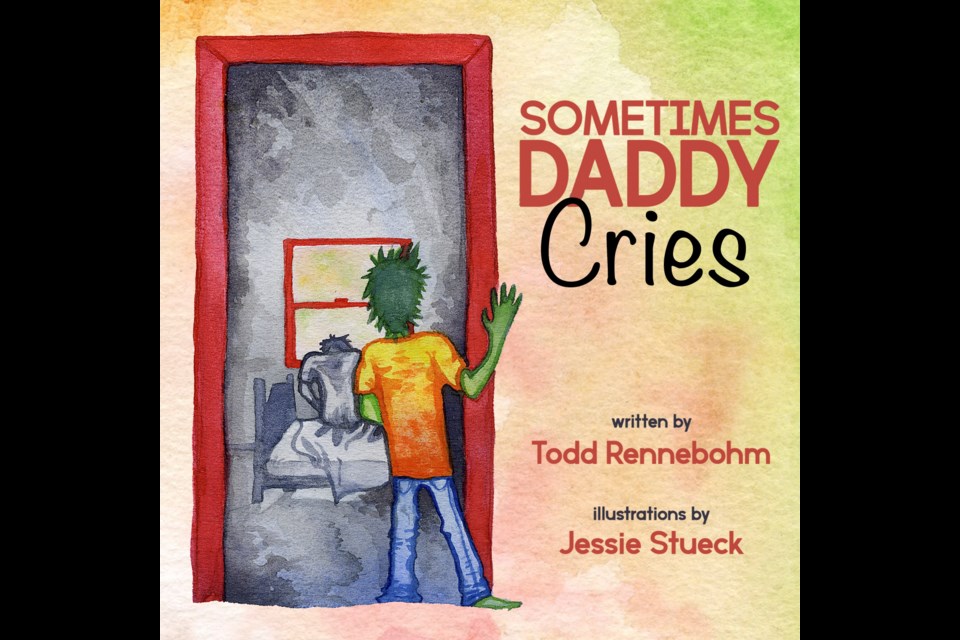Understanding depression is not easy, especially for the children of those suffering from it.
A new book attempts to help kids understand better.
Sometimes Daddy Cries is told through the eyes of a boy whose father suffers from depression. He sees his dad get sad, rest and even go to the hospital, all while comparing his father's depression to a physical ailment.
The book is by Indian Head author Todd Rennebohm. He is a husband and father of two boys who has been advocating for mental health issues since 2016.
Rennebohmhas personal experiences with anxiety, depression and addiction. Today he is in recovery and works with others as a support in an addiction treatment centre.
The book is Rennebohm’s first.
“I have no formal training as a writer but a letter I wrote over four years ago went viral and got a lot of media coverage about my issues with mental health and about the health region cutting 12 jobs at the psych ward in Regina,” he said.
The exposure of the letter helped him take the plunge into writing more deeply.
“I don't remember exactly the moment I got the idea for the book,” said Rennebohm.
“I do know the night I wrote the first draft was the night I quit drinking. I was drinking in my garage and smoking lots of pot that night (and every night). I was having lots of trouble with depression, anxiety and addiction issues at that point in my life.
“I had already survived a suicide attempt and a couple stays in the psych ward a couple years before and I could feel myself starting to spiral again.
“I remember coming into the house sitting down at my laptop and starting the first draft while sobbing.
“Shortly after that I woke my wife up to help me because I was having thoughts of harming myself again. She eventually got me to the local hospital. I've been sober ever since that night nearly four years ago which in turn has helped my depression and anxiety significantly.”
While the writing obviously was part of Rennebohm’s own journey, why did he want to take it to a broader audience?
“After my suicide attempt and stays in the hospital, I could see the affect it was having on my children and our relationships,” he said. “They seemed to walk on eggshells around me and we began to have a bit of a disconnect.
“I don't remember having talks with them about mental health or illnesses and wished I had.
“This book was worth writing if it could help other parents begin the conversation about mental health with their children, if parents can normalize mental illness and if kids at a young age can feel some empathy for people suffering with mental illnesses like they do for people with physical ailments. Education is always worth writing about.”
Given the subject matter how difficult was the writing process?
“I really used my own story to help with the process,” said Rennebohm.
“I had many days where I never left bed, sometimes for many days in a row, and there were times I openly cried in front of my family. I wanted those moments in the book.
“My kids often visited with their grandparents when I was in the hospital or in bed for days and I wanted that in the book as well.
“Once I had a flow and the story of the progression of the father’s depression I needed to add the kid comparing his father's illness to a physical illness.
“Once I did that, it began to have a bit of a flow.
“From there I edited several times, changing the flow of a sentence or coming up with more kid friendly words. Once I was somewhat happy I had some therapists, counselors and other professionals read it and give feedback.
“I then took that feedback into consideration and made more changes until I felt it was complete?
And there was also the challenge to write for a younger audience.
“There were definitely challenges writing a kids book about mental illness,” said Rennebohm. “I didn't want the book dark and sad, but I also didn't want the book to be so fluffy that it made light of depression. It was tough to give realistic expectations about depression without it being scary or dreadful.”
Even though Rennebohm wrote the book he was quick to tip his has to his illustrator when asked what the best aspect was.
“Honestly I find the best aspect of the book to be the illustrations by Jessie Stueck,” he said. “She created images that not only are beautiful but also set a mood. You can almost feel the images. When she sent me her first bundle of illustrations and I took a look at them, I became emotional. The style, her colour choices, every decision she made was perfect for the book.”
But the author is also happy with what he created.
“I really am satisfied with the story and the book in general,” said Rennebohm. “It took four years off and on, but I do feel the story and the message is exactly what I wanted portrayed.”
There is also a significant potential audience for the book, said Rennebohm.
“Mental health and illness affects everyone in one way or another; every socio-economic background, every race, and every age, so for that reason I honestly see the target audience being all children,” he said.
The book is available online at various booksellers.



